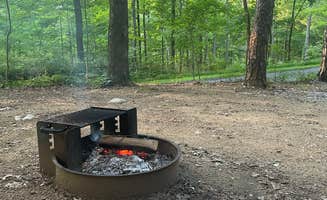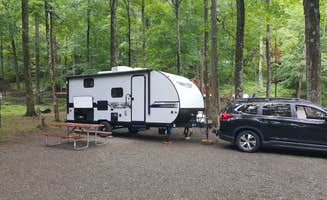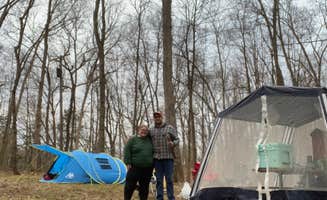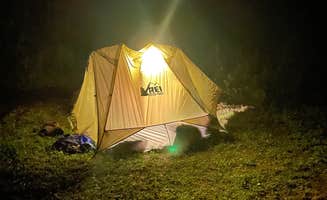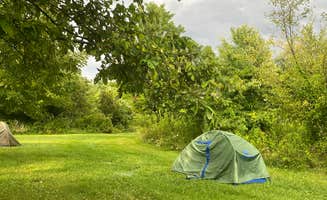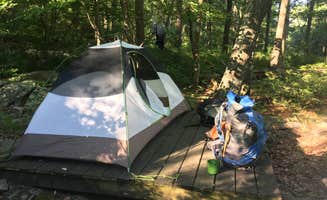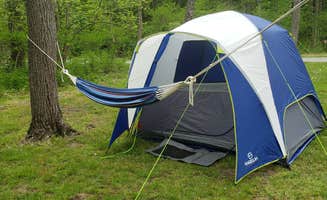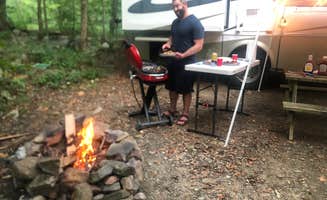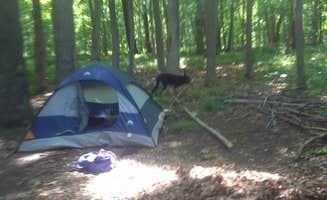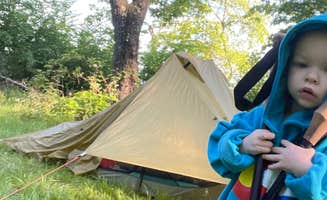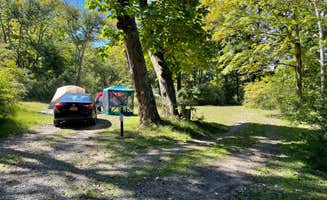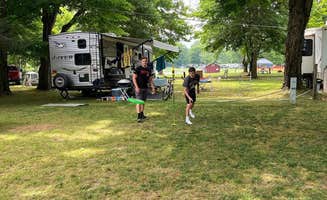Camping spots near Johnsonburg, New Jersey range from secluded forest settings to riverside locations along the Delaware. The Kittatinny Mountains provide varied terrain with elevations from 400 to 1,600 feet throughout the region. Night temperatures can drop below freezing even in spring, with a recorded low of 24°F in April at some campgrounds.
What to do
Hiking to the Lakota Wolf Preserve: At Camp Taylor Campground, visitors can take a short hike to see wolves in a sanctuary. "There are moments by the fire you can hear them howl in the distance. It's one of our favorite places to camp," notes Julie F. The preserve offers educational tours with discounted rates for campers.
Paddling on the Delaware River: Several campgrounds offer direct river access for kayaking and canoeing. "Perfect site on the Delaware with a short walk down to be able to launch our canoe and kayak," writes Mitchell E. about Worthington State Forest Campground. The water is warm enough for comfortable paddling through summer and early fall.
Exploring Ghost Lake: Located within Jenny Jump State Forest, this uniquely named lake provides an interesting hiking destination. "Nice big group site and fun walk to Ghost Lake," reports Doug W. The trail system connects directly to campsite areas, allowing for exploration without driving.
What campers like
Privacy between sites: Many campers value the space and separation at certain campgrounds. At Jenny Jump State Forest, "the camp sites are nicely laid out to ensure privacy. This park is high up on a mountain and affords lovely views," according to Jocelyn G. Sites tend to be more secluded in the higher-numbered areas.
Clean facilities: Maintenance standards are frequently mentioned in reviews. "The bathroom/shower was only a few steps away which was convenient and clean," notes Kelsey K. about her experience at Jenny Jump. Similarly, at Driftstone Campground, a camper mentioned "the bathrooms are super clean and had the nicest showers I have ever seen at a campground."
Free boat rentals: Some campgrounds offer complimentary watercraft. "Kids had lots of fun on the free kayaks and pool," reports Jojo P. about Great Divide Campground. These amenities make water activities more accessible for families without needing to bring or rent equipment elsewhere.
What you should know
Terrain challenges: The topography can be difficult for some camping setups. "Campgrounds have lots of hills so be prepared to hike up and down," warns Jojo P. about Great Divide. At Stokes State Forest, "the sites are hit or miss in terms of comfort, some have large, flat, clear spaces for multiple tents, some you have to wedge a tent to avoid rocks," says Seth K.
Wildlife awareness: This region requires proper precautions for local wildlife. "Remember, this is bear country so proper food storage is a must. Bear lockers are not provided. The area also has ticks and rattlesnakes," advises one reviewer about Stokes State Forest. Several campgrounds post warning signs and provide guidance on safe food storage.
Reservation requirements: Most campgrounds fill quickly during peak season. "We arrived at our site later than the check in time, had a bit of trouble finding it but once we did it was easy enough," shares Christine N. about Worthington State Forest. Weekends from Memorial Day through Labor Day typically require booking weeks or months in advance.
Tips for camping with families
Look for campgrounds with scheduled activities: Families appreciate organized programming. "They had different activities. And had (socially distanced) trick or treating for kids!" notes Angela about Mountain Vista Campground. The campground's calendar often includes craft sessions, movie nights, and seasonal celebrations.
Choose sites near playgrounds: Strategic site selection helps with child entertainment. At Delaware Water Gap KOA, "a big playground was directly in front of us, which worked out perfectly since we have school age kids," shares Penny C. These locations allow parents to supervise from their campsite while preparing meals or relaxing.
Prepare for varying water conditions: Swimming options differ significantly between locations. At Swartswood State Park, "There are picnic spots right on the lake if you want to spend the afternoon at the lake," explains Ethan K. Some campgrounds maintain designated swimming areas while others prohibit water entry due to underwater hazards.
Tips from RVers
Mind the road access: Some campgrounds have challenging approach roads. At Driftstone Campground, "PLEASE NOTE: if you are towing or have a motorhome, make sure you follow the directions on the website. Coming in from the wrong road could lead you to a hairpin turn and steep hill," warns Jim G. GPS directions often route vehicles on unsuitable roads.
Check site dimensions carefully: Size restrictions vary significantly between campgrounds. "Only a handful of full hook up sites surrounded by seasonal cottages. Other area of the place had water and electric but it would be hard to get in/out of if it had rained a lot as it was all on soft grass," reports April L. about Panther Lake Campground.
Consider alternative accommodations: Several campgrounds offer cabin options for those without RVs. "If you want, they have the option of renting a small cabin/shelter that you can stay in if you are not into tent camping," explains Ethan K. about Jenny Jump State Forest. These options typically include basic amenities like beds and electricity without the need for hookups.


